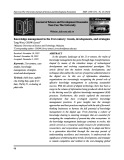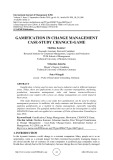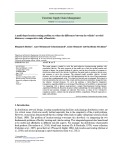
http://www.iaeme.com/IJMET/index.asp 944 editor@iaeme.com
International Journal of Mechanical Engineering and Technology (IJMET)
Volume 10, Issue 03, March 2019, pp. 944-951. Article ID: IJMET_10_03_095
Available online at http://www.iaeme.com/ijmet/issues.asp?JType=IJMET&VType=10&IType=3
ISSN Print: 0976-6340 and ISSN Online: 0976-6359
© IAEME Publication Scopus Indexed
FACTORS PROMOTING STAKEHOLDER
MANAGEMENT OF BUILDING PROJECTS
Opeyemi Oyeyipo*
Covenant University, Ota, Ogun state, Nigeria
Henry Odeyinka
Obafemi Awolowo University, Ile-Ife, Osun state, Nigeria
James Owolabi and Rapheal Ojelabi
Covenant University, Ota, Ogun state, Nigeria
ABSTRACT.
The purpose of the study is to assess the factors promoting stakeholders’
management of building projects in Nigeria with a view to managing the various
interests of stakeholders on building projects. The research is a project-based study
where fifty nine building projects were sampled. The study adopted cross-sectional
research design, while research questionnaire was used to elicit information from the
project leaders of the selected building projects. Purposive sampling technique was
used to draw up the target respondents. Findings reveal stakeholders’ potential for
cooperation, the control level of engagement of stakeholders, positive stakeholder’s
interest towards the project and effective communication among stakeholders are the
most significant factors promoting stakeholders’ management in building project
delivery within the study area. The study also revealed that there is no significant
difference among project leaders on the factors promoting stakeholder’s management
of building projects in Nigeria.
Keywords: Building project,Project delivery, Stakeholders, Stakeholder management,
Cite this Article Opeyemi Oyeyipo, Henry Odeyinka, James Owolabi and Rapheal
Ojelabi, Factors Promoting Stakeholder Management of Building Projects, International
Journal of Mechanical Engineering and Technology, 10(3), 2019, pp. 944-951.
http://www.iaeme.com/IJMET/issues.asp?JType=IJMET&VType=10&IType=3
1. INTRODUCTION
Construction project delivery involves a cycle of interrelationships between stakeholders and
strings of complex activities leading to achievement of client’s objectives. The quality of
interrelationships between the project team and other construction stakeholders depends on
organization’s culture, source of funding and stakeholders involved on construction projects
(Sauer, 1993). There exist different levels of interests for every group and individuals involved

Opeyemi Oyeyipo, Henry Odeyinka, James Owolabi and Rapheal Ojelabi
http://www.iaeme.com/IJMET/index.asp 945 editor@iaeme.com
in construction project delivery. Cleland (1999) and Karlsen (2002) reiterated that the tendency
to manage stakeholders as well as ensuring there is a balance between their interest and
contributions in construction projects are essential for successful project outcome. This
ultimately makes it important for project leaders to manage different interests and stakes of
project stakeholders in order to have positive outcomes in terms of client’s satisfaction.
The number of stakeholders involved in construction projects increases the interests as well
as the uncertainties in the project. This is confirmed by Karlsen (2008) who argued that each
stakeholder have different interest which places them in conflict with the project objectives.
Stakeholder’s interest can either be in support or opposition with the project objectives. Some
stakeholders’ interest have more basis and footing than some others. The stakes of different
stakeholders in building project delivery could include but not limited to professional fees,
involvement in special type of projects, relevance in the industry and any other reasons which
might not be known at the inception of building projects. Notwithstanding, the project leaders
in the construction industry are expected to be able to manage stakeholders and their respective
interests in the execution of such building projects.
While El-Gohary, Osman and Ei-Diraby (2006) maintained that stakeholder management
has been seldom embraced in the construction sector, the construction industry has persistently
recorded poor stakeholder’s management in the last two decades (Chinyio&Olomolaiye, 2010).
The poor record of SM in the built environment could be linked to different interests and
uncertainty arising from various construction projects. Bourne (2005) argued that construction
project outcome is reliant on the expectation and perceptions of project participants coupled
with the capacity of the project leader (PL) to manage the project politics among stakeholders.
The outcome of construction projects is dependent on stakeholders’ disposition to the project
and the willingness of the project manager to manage the interests of the project stakeholders.
The study is set out to examine the factors promoting stakeholder management in building
project delivery as well as assessing the opinions of different stakeholder management. The
study will provide valuable insight to project leaders of building projects about the significant
factors promoting stakeholder’s management in the construction process.
There have been several studies on critical success factors of stakeholders’ management in
construction projects. These factors include activities or considerations that ensure successful
stakeholder management. Yang, Shen, Ho, Drew and Chan (2009) confirmed fifteen (15)
critical success factors for SM in developing countries, while El-Sawalhi and Hammad (2015)
identified twenty three (23) critical success factors for SM under six dimensions or groups in
Gaza strip construction industry. Olander and Landin (2008)embarked on a research to examine
comparative study of factors affecting external stakeholder management process and
highlighted five factors for the variances in the outcomes of the stakeholders’ management
process in project delivery. The major constraint with the studies reported is the inability to
examine the holistic factors influencing stakeholder management as against the critical success
factors which has flooded literature. In addition, most of the factors identified in the studies
reported did not capture those peculiar to the Nigerian construction industry.
2. REVIEW OF LITERATURE
There have been several definitions from different scholars on stakeholder management. The
concept according to Li et al. (2011) is the efficient management of relationships among project
stakeholders. Karlsen (2002) and Bourne and Walker (2006) defined stakeholder management
with different statements but both reckoned that the concept involves the management of
activities related to project stakeholders. The latter however hinted that the management process
encourages the use of proactive project manager to reduce the negative effect of stakeholder
activities and ensure stakeholder support to achieve project goals. This infers that project leader

Factors Promoting Stakeholder Management of Building Projects
http://www.iaeme.com/IJMET/index.asp 946 editor@iaeme.com
will make use of strategies to reduce project stakeholder activities that affect project negatively
and support activities that influence the project positively.
Project Management Institute (2014) described project stakeholder management as the
systematic identification, analysis, and planning of actions to communicate with and impact
stakeholders. The identification of stakeholders, the tendency to analyse the influence of
stakeholders, communication among stakeholders are few of the activities to be managed by
the project leader. Aaltonenet al. (2008) indicated that stakeholder identification and analysis
is aimed at facilitating the understanding of how to manage stakeholders in constantly changing
and unpredictable environments. Persson and Olander (2004) further defined successful
management of stakeholders to involve actively giving and getting stakeholder’s support and
working together to devise, plan and develop or bring new project on board. Stakeholder
management is focused on harmonizing the contributions of participants to enhance the project
outcome.
The effective stakeholders’ management in construction project delivery has a great
contribution to the successful outcome of project (El-Naway, Mahdi, Badwy and Al-Deen,
2015). The success of building projects is dependent on the ability to manage diverse
individuals with stakes in the project. [24] stress that stakeholders in a construction project have
considerable interest and needs in the project which should be understood during the
construction process. Bal, Bryde, Fearons and Hanif (2017)maintained that an effectively
managed stakeholder engagement process improves quality performance of such projects while
increasing the economic sustainability of the project. Such engagement process breeds a
positive relationship among stakeholders. There are however benefits which accrue as a result
of stakeholder management and engagement; stakeholders possess increased wealth of
information, better understanding of the construction market condition, promotion of
stakeholder reputation, cordial relationships, understanding of stakeholders’ priorities and
needs, understanding and mitigation of threats as well as uncertainties. While some of the
factors have organizational inclination, others are related to project environment,
communication, contractual, and regulatory issues (Ekung, Okonkwo and Odesola, 2014).In
the same light, Ihugba and Osuji (2011) reflected that barriers on the part external stakeholders’
community arise from lack of awareness,Olander and Landin (2008) upheld that paying
attention to the long term objectives of projects at the detriment of the short term objectives of
community stakeholders can also breed public resistance. The authors further stated that
insufficient allocation of time and resources can also steer up sub-optimal outcome, and strong
resistance.
3. RESEARCH METHOD
This section outlines the procedure for conducting the study. It discusses the research design,
population of the study, sampling techniques, method for data collection and statistical tools
for analysing the collected data. A survey research design was adopted in the study because
information/opinions were sought from a cross section of project leaders on selected building
projects in the study area. Specifically, a cross-sectional research design was used where
samples were drawn from the population of study at one point in time. The study was conducted
in Lagos state which is economically an important city in Nigeria. The study was a project
based research similarly to researches carried out by (Ogunde, Olaolu, Afolabi, Owolabi &
Ojelabi, 2017; Amusan, Tunji-Olayeni, Afolabi, Omuh, Ojelabi & Oluwatobi, 2016; Ojelabi,
Oyeyipo, Afolabi & Amusan, 2018, Oyeyipo, Odusami, Ojelabi and Afolabi, 2016). Hence, the
research instrument was prepared and administered to project managers/leaders of selected
building projects in such a way that the study can get in depth information related to the factors
promoting stakeholders’ management of building projects. Purposive sampling, which is a non-

Opeyemi Oyeyipo, Henry Odeyinka, James Owolabi and Rapheal Ojelabi
http://www.iaeme.com/IJMET/index.asp 947 editor@iaeme.com
probabilistic sampling technique was adopted for the study due to the study’s inability to obtain
a current and comprehensive list of all the building projects currently ongoing in Lagos as at
the time of carrying the study.
The study selected 91 (ninety one) building projects with its project leaders within the study
area. However, it must be said that some of the building projects did not have statutory project
managerswhile the others did. Out of the seventy (72) copies of research questionnaire
administered to the respondents via an online questionnaire survey, 61 were completed and
returned.
Table 1: Respondents response rate
N
%
Total administered
91
100
Total returned
61
67
Total used for the analysis
53
58
The returned questionnaires were then assessed and only fifty three (53) were discovered
adequate for the study, representing a 58% response rate. Some of the returned questionnaires
were assessed and those not filled properly were discarded so as not to alter the outcome of the
research.
4. RESULTS AND DISCUSSION
4.1. Characteristics of the respondents
The analysis of the data revealed that majority (94%) of the respondents that participated in the
questionnaire survey has formal education which makes them important for the study. Thirty
percent of the project leaders are architects, 20% are quantity surveyors, 11% and 17.3% are
builders and civil engineers respectively while the remaining are service engineers and other
allied professionals. It is imperative that majority of project leaders have professional
background in architecture and quantity surveying. The working experience of the respondents
has spanned over the years in the construction industry. 47.2% of the respondents have worked
for 1-10 years, 30.2% have between 11-20 years of experience, 20.8% between 21-30 years of
experience whereas the rest (1.9%) have worked for 31-40 years. This therefore implies that
the project leaders of the selected building projects have been involved in building project
delivery and hence knowledgeable about stakeholders’ related matters in the construction
industry.
4.2. Factors promoting stakeholders’ management of building project
To achieve the objective, there are seventeen (17) factors promoting stakeholders’ management
of building projects obtained from literature. This was done by requesting the respondents to
rate the level of significance of probable factors identified from literature. The mean scores of
the significance of the factors are presented in Table 2.
Table 2: Factors promoting stakeholders’ management of building projects
Factors
Mean
Rank
Control level of engagement of stakeholders
3.47
1
Stakeholders potential for cooperation
3.31
2
Positive stakeholder interests towards the project
3.29
3
Communication among stakeholders
3.28
4

Factors Promoting Stakeholder Management of Building Projects
http://www.iaeme.com/IJMET/index.asp 948 editor@iaeme.com
Pre-existing cordial relationship between stakeholders
3.28
4
Co-operative stakeholders behaviour on the project
3.26
6
Stakeholders identification and role definition
3.23
7
Classification of stakeholders into supporters, neutral and resistant group to the
project
3.22
8
Areas of stakeholders interest/need in the project
3.18
9
Change of stakeholders relationship during the project
3.17
10
Relationship btw project management team and stakeholders
3.16
11
Stakeholders potential for threat on the project
3.15
12
Stakeholders known attributes on projects
3.13
13
Stakeholder coalition among themselves
3.09
14
Strategies for managing stakeholders
2.98
15
Project task assigned to stakeholders at different stages
2.77
16
The power and influence of stakeholders on the project
2.75
17
Table 2 shows that control level of engagement of stakeholders (mean score - 3.47),
stakeholders potential for cooperation (mean score – 3.31), positive stakeholder’s interests
towards the project and communication among stakeholders are the most significant factor
promoting stakeholders management of building projects. The control level associated with the
engagement process of stakeholders is an essential factor promoting stakeholders’ management.
The level of control and power given to stakeholders engaged ultimately will affect the
management of stakeholders in the building project delivery. In the same vein, the positive
stakeholder’s interests towards the actualization of the building project are essential for
achieving effective and efficient stakeholder management. Similarly, the tendency of
stakeholders to corporate with the project leader is a good indication that stakeholders will be
managed properly. Factors like change of stakeholders interest on the project, classification of
stakeholders into supporters and resistant group to the project, pre-existing cordial between
stakeholders, stakeholders behaviour on the project, stakeholders identification and
classification of stakeholders are also significant but not as the earlier significant factors.
On the other hand, areas of stakeholders interest in the project, change of stakeholders
relationship during the project, relationship between project management team and
stakeholders, stakeholders potential for threat on the project, stakeholders known attributes on
projects and stakeholders coalition among themselves are the fairly significant factors.
Notwithstanding, factors such as strategies for managing stakeholders, project task assigned to
stakeholders at different stages and the influence of stakeholders on the project are the least
significant factors. It is however surprising to note that task assigned to each of the stakeholders
at different stages is said to have least influence of stakeholders’ management.
The study revealed that control level of engagement of stakeholders and stakeholders
potential for cooperation are the most significant factor influencing stakeholders’ management
of building projects. This is consistent with previous studies, for instance, [23] related the
importance of stakeholders’ engagement control to observing overall stakeholder relationships
and associated management strategies. The advantage derivable from the stakeholders’
management process is tied to maintaining and increasing the efficacy of stakeholders’
engagement as the proposed project evolves over time and its environment changes. Factors
like change of stakeholders interest on the project, classification of stakeholders into supporters
and resistant group to the project, pre-existing conflicts between stakeholders, stakeholders
behaviour on the project, amongst others also have significant impact but not as the former.





















![Tài liệu Quản lý dự án: Kiến thức nền tảng toàn diện [chuẩn SEO]](https://cdn.tailieu.vn/images/document/thumbnail/2025/20250910/kimphuong1001/135x160/92631757496585.jpg)




